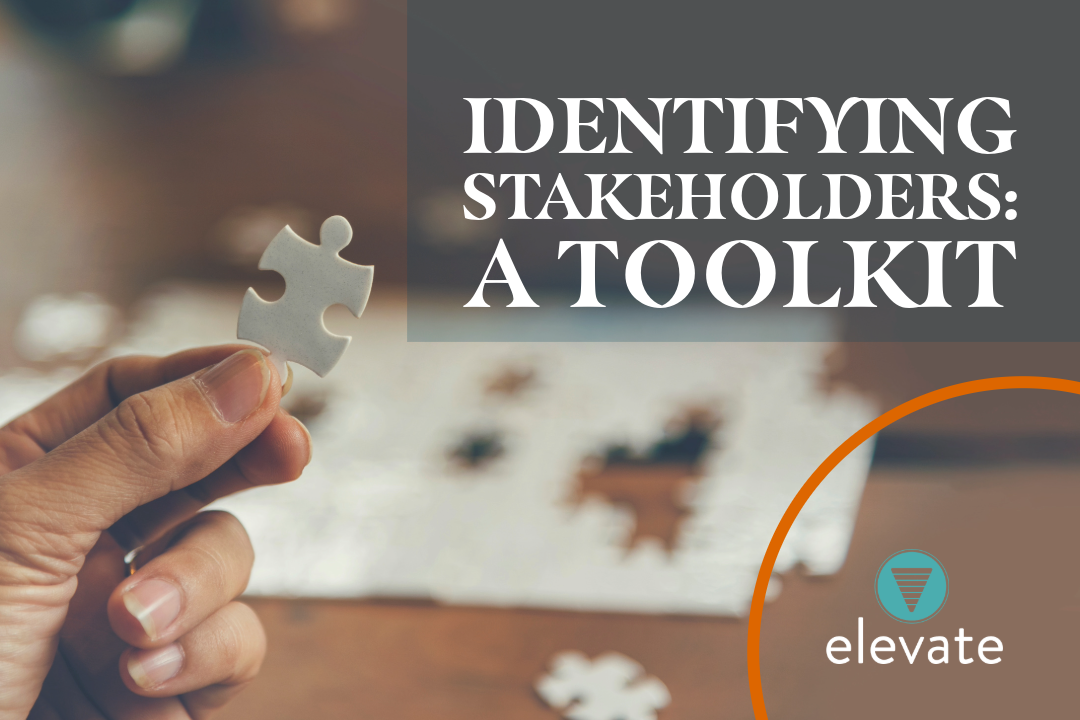Identifying Stakeholders: A Toolkit
Written by Alyssa Reynolds
Stakeholders Defined
It is likely that the term “stakeholders” is one you’ve heard before. It’s used across sectors to describe someone who has an interest in and/or is affected by a business, an investment, a project, etc. Stakeholders can be individuals, communities, social groups, or organizations. At Elevate, stakeholders are an essential part of our approach to evaluation and to systems change work.
How to Identify Stakeholders
The definition above may seem broad and ambiguous—and it is! Stakeholders vary based on a number of factors and can change within an organization over time or by nature of each project. To make the process of identifying the right stakeholders less overwhelming, the CDC suggests thinking about stakeholders in four categories:
Implementers: carry out the day-to-day operations of the project or program.
Decision Makers: have existing authority to make changes.
Participants: clients served by the project or program.
Partners: invested/interested in the project or program.
The process of identifying stakeholders can be carried out and documented in a variety of ways. At Elevate, we prefer to use different visual tools like mapping, sticky notes or Miro, and guided worksheets. Visual tools ensure documentation of the stakeholder identification process and allow the process to remain iterative and participatory.
Stakeholders and Equity
What does this process have to do with equity? Historically, stakeholder engagement has been focused more on those holding interest and less so on those who may be affected. Though not always intentional, it can be easy to focus our attention on those who hold decision making power or those more directly involved in the project or program. In order to avoid these kinds of oversights, Mayers (2005) suggests some additional questions we can use as to guide our process:
Who are potential beneficiaries?
Who might be adversely affected?
Who has existing power and influence?
Who is likely to be voiceless?
Who is likely to resent change and mobilize resistance against it?
Who is responsible for intended plans?
Who has money, skills or key information?
Whose behavior has to change for success?
Once you begin mapping out potential stakeholders based on the questions above, it is important to also consider representation. Do the stakeholders you see on your list or diagram represent the broader group they belong to? Here are some aspects of identity to consider in this process of reflection:
Gender identity
Age
Race and Ethnicity
Socioeconomic status
Role
Location
Stakeholder Analysis
Once you have identified a list of potential stakeholders, another important step in this process is to conduct a stakeholder analysis. There are many ways of doing this and different tools available to guide your process. Some basic questions we recommend answering for each stakeholder are:
Role
Why are they important?
Current attitude toward the project
What would we like them to do?
What types of data do they find credible?
What types of data can they provide?
What institutional/organizational factors affect this person?
What motivates this person?
How is this person currently engaged?
How are you going to engage this person going forward?
In certain situations, an additional phase of stakeholder analysis may be appropriate. Mayers recommends a power analysis that examines who has power to influence and who has power to act. Guiding questions for this process include:
Who is dependent on whom?
Which stakeholders are organized?
Who has control over resources?
Who has control over information?
Which problems, affecting which stakeholders, are the priorities to address or alleviate?
Which stakeholders’ needs, interests and expectations should be given priority attention with respect to the policy or institution in question?
Stakeholders in Evaluation
Stakeholder involvement in evaluation is important for a number of reasons. Involving stakeholders in evaluation can:
Reduce distrust or fear surrounding evaluation and data more broadly.
Reduce risk of missing important pieces of context or data.
Increase the sense of data ownership and, in turn, usability.
Increase awareness.
Increase support, buy-in, and participation.
Increase the credibility of findings.
Provide valuable and unique insider insights.
Create necessary feedback loops.
When to Engage Stakeholders
When to involve stakeholders in the evaluation process is another variable to determine with your team. Once you have identified your project stakeholders and have completed initial stakeholder analysis, you can begin to collaborate on a stakeholder engagement plan. Depending on the nature of your project and of your stakeholder relationships, it may be appropriate to involve stakeholders early on and for each stage of the process. In other cases, it may be appropriate to involve them less frequently during certain phases of the work.
In summary, the stakeholders identified and the level of engagement determined is up to you. However, it is important to use--and point to documentation of--an intentional process that led you to these decisions. Not only can this improve the quality of your work, add to its credibility, and increase buy-in, but it can also expose and help to inform change around power imbalances and inequities.
Tools
https://coast.noaa.gov/digitalcoast/training/stakeholder-analysis-worksheet.html
References:
Salabarría-Peña, Y, Apt, B.S., Walsh, C.M. Practical Use of Program Evaluation among Sexually Transmitted Disease (STD) Programs, Atlanta (GA): Centers for Disease Control and Prevention; 2007.
Mayers (2005). Power tools: Stakeholder power analysis. International Institute for Environment and Development.
Measure Evaluation (2011) Tools for Data Demand and Use in the Health Sector: Stakeholder Engagement Tool. Measure Evaluation Manual.


